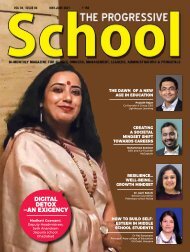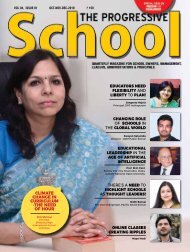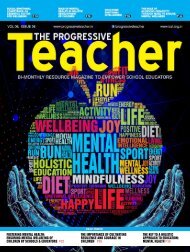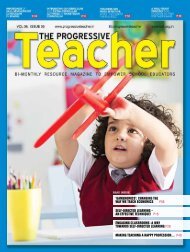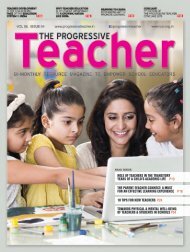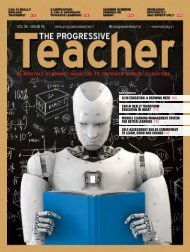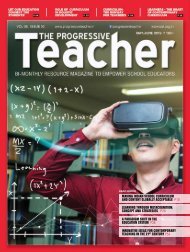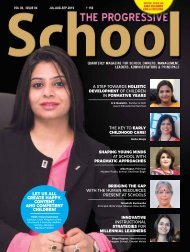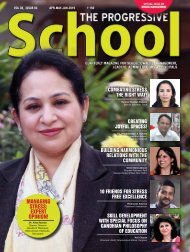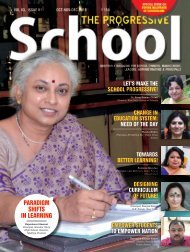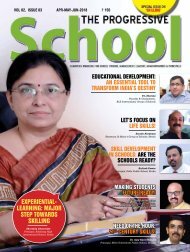The Progressive School Vol 02 Issue 04
The Progressive School is a quarterly magazine for school owners, leaders and principals. It will continue to address vital issues that impact the emerging challenges in the design, administration and growth of schools in all its dimension.
The Progressive School is a quarterly magazine for school owners, leaders and principals. It will continue to address vital issues that impact the emerging challenges in the design, administration and growth of schools in all its dimension.
You also want an ePaper? Increase the reach of your titles
YUMPU automatically turns print PDFs into web optimized ePapers that Google loves.
for both the world of work and success in<br />
life. <strong>The</strong> pedagogy should address deeper<br />
learning and foster higher order thinking<br />
skills. <strong>The</strong> pedagogy needs to be changed<br />
to make the learner to communicate and<br />
collaborate and not to be a passive listener.<br />
Deep understanding and actionability<br />
for the real world will occur only by<br />
embedding skills within the knowledge<br />
domain such that each enhances the other.<br />
Emotional stability and health education<br />
are to be factored in the school curriculum.<br />
<strong>The</strong> in-service education for the<br />
teachers should reflect the above and to<br />
make students equip for future challenges,<br />
we need to give them a voice (i.e) they have<br />
to be responsible for their likes and choices.<br />
<strong>The</strong> goals of education and of a school<br />
should aim to synthesize and contribute<br />
on why skills matter and which skills<br />
are important for learning and future<br />
outcomes.<br />
TPS: Many schools believe that<br />
provision of informal support to<br />
learning for extended and impactful<br />
learning comes with the cost which<br />
parents cannot afford and hence find<br />
it convenient to marginalize them.<br />
Is there a scope for integrating such<br />
learning experiences with curricular<br />
architecture and how do you think<br />
this can be done?<br />
Uma: According to me, it’s a myth that<br />
quantum of learning is directly proportional<br />
to the cost of learning materials. <strong>The</strong><br />
curriculum design of a school should create<br />
learning outcomes and learning objectives<br />
to match the learning environment<br />
without compromising the standards.<br />
Mapping the available resources with<br />
the curriculum will be an added value to<br />
provide significant learning experiences.<br />
Seminars, study sessions, workshops<br />
provide opportunities for the students to<br />
meet the standards. Retaining teachers<br />
with such skills who care about the<br />
subject, their learners and about teaching<br />
and learning will be productive for the<br />
organization. Usage of active learning, the<br />
system of feedback that promotes impactful<br />
learning, interaction with the students,<br />
www.progressiveschool.in<br />
Uma Ramesh<br />
challenging students to make progress<br />
in learning could be considered in the<br />
curricular design of the school. A mindset<br />
is required to thoughtfully integrate<br />
various disciplines that provide a strong<br />
foundation in conceptual understanding<br />
and optimizing the usage of resources.<br />
TPS: Learning beyond” is fundamental<br />
to “Learning always” and“Life long<br />
learning.” It is development of a<br />
mindset and attitude to learning<br />
which is required for a vibrant<br />
knowledge society and a global<br />
learning environment. How can this<br />
idea be seeded in the young mind<br />
which would trigger them to be<br />
powerful “Self learners”?<br />
Uma: Children come to school with an<br />
open mind and willing to learn. <strong>The</strong><br />
schools should foster and strengthen this<br />
predisposition and ensure that young adults<br />
leave the school with the motivation and<br />
capacity to continue learning throughout<br />
life. To do this, the school should establish<br />
the goals, to persevere, to monitor their<br />
learning progress, to adjust the learning<br />
strategies as necessary and to overcome<br />
difficulties in learning in the big picture of<br />
the curriculum map. Students interest to be<br />
fostered and positive attitude towards the<br />
subject to be reflected in the curriculum.<br />
As the majority of students, learning<br />
time is spent in school, the climate of<br />
the school is important for the creation of<br />
“Learning beyond,” and effective learning<br />
environment. Learning beyond always<br />
kindles the curiosity of the child and some<br />
of the non-cognitive outcomes of schooling<br />
that serves the purpose of education. <strong>The</strong><br />
concept of personalized learning and<br />
individual learning targets are the force<br />
behind learning which steers the plan of<br />
the curriculum.<br />
TPS: In a world haunted by technology,<br />
most learners spent their time with<br />
the instruments of technology for<br />
further and extended learning. What<br />
are its advantages and shortfalls?<br />
How do you think this mindset can be<br />
changed to a positive and personalized<br />
interactive social learning culture?<br />
Uma: “We are living in the world where<br />
technology almost surpass humanity,”<br />
said Albert Einstein. Use of these hi-tech<br />
mechanizations hinders the steps of<br />
learning and also demolishes the creativity<br />
and thinking skills of learners. <strong>The</strong> learners<br />
are misguided by wrong information<br />
available that become a serious obstacle in<br />
their development. <strong>The</strong> click of a mouse has<br />
the power to control everything and makes<br />
the learners lazy and disconnected from<br />
the real world. Students use technology<br />
in place of handwriting which slows<br />
down the writing skill and thinking<br />
processes. Though e-books are handy<br />
and eco-friendly, replacing books with<br />
e-books causes eye strain and are not<br />
cost effective at times. On the other hand,<br />
technology should be fused with the<br />
method of teaching to make learners’ brain<br />
working instead of being totally dependent<br />
on them. If used appropriately, it has<br />
the great potential to enhance students’<br />
achievement and teachers learning. <strong>The</strong><br />
new software and applications which<br />
are interactive could be used to create<br />
environment in which students can learn<br />
by doing, receive feedback and continually<br />
refine their understanding and build new<br />
knowledge. Bringing exciting curricula<br />
based on real world problems by providing<br />
scaffolds and tools to enhance learning will<br />
provide expanding opportunities for the<br />
teacher and the taught. Create an active<br />
environment in which students not only<br />
solve problems and also find their own<br />
problems/queries could be done through<br />
appropriate software. For example in a<br />
banking simulation, students assume<br />
roles, such as vice president of a bank<br />
and learn about the knowledge and skills<br />
needed to perform various duties.<br />
JUL-AUG-SEP 2018<br />
THE PROGRESSIVE SCHOOL<br />
15




